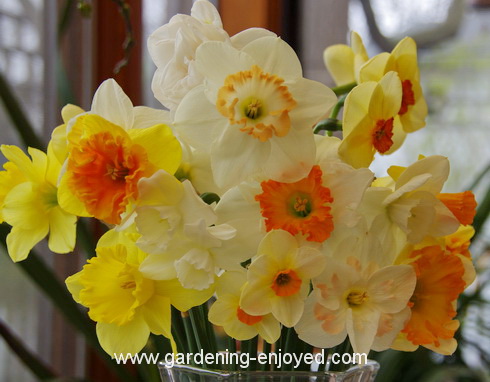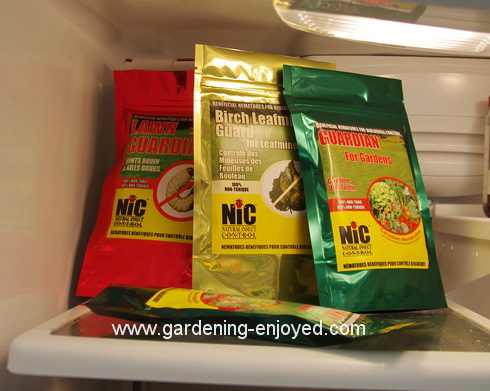| Back to Back Issues Page |
 |
|
Dallying In The Dirt, Issue #362 - We are calling this the cold weather edition. May 12, 2020 |
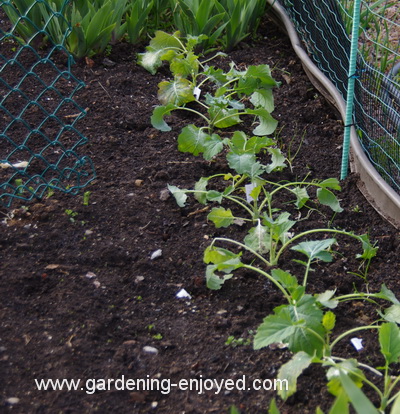 Continuing with our cold theme, here is a picture this morning of a row of Kohl Rabi plants that were standing up and looking healthy yesterday. Over in the other corner the Tulips that were standing up straight and proud yesterday were, once again, bent over and apparently bowing to visiting dignitary, probably Mother Nature in her fur coat. It's now noon and the KohlRabi and Tulips have almost returned to their upright posture without too much obvious damage. We won't be eating that Kohl Rabi anytime soon; it's more interested in survival than actual growth.
Continuing with our cold theme, here is a picture this morning of a row of Kohl Rabi plants that were standing up and looking healthy yesterday. Over in the other corner the Tulips that were standing up straight and proud yesterday were, once again, bent over and apparently bowing to visiting dignitary, probably Mother Nature in her fur coat. It's now noon and the KohlRabi and Tulips have almost returned to their upright posture without too much obvious damage. We won't be eating that Kohl Rabi anytime soon; it's more interested in survival than actual growth.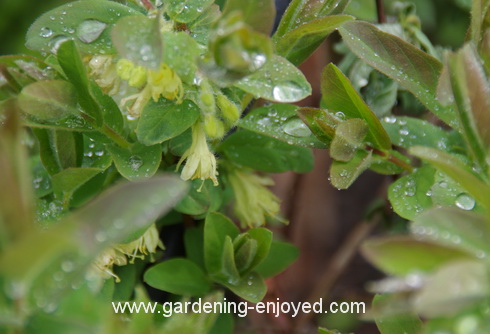 The open flower in the centre of this picture is on my Haskap Berry bush. Haskap is the Japanese name for Lonicera caerulea a non climbing Honeysuckle that is native to many temperate parts of N. America and Japan where they have been cultivated and consumed for ages. The modern varieties that we see here were bred at the University of Saskatchewan and are obviously very hardy. Haskap berries are high in Vitamin C and A, fiber, and potassium. Specifically they have three times the antioxidants of a blueberry, more vitamin C than an orange and almost as much potassium as a banana. They are extremely high in antioxidants such as Anthocyanins, Poly Phenols, and Bioflavanoids. Haskap does not have separate male and female plants. When two compatible haskap varieties are planted close to each other, both bushes will set fruit. It's not enough to have compatible pollen, though. To pollinate each other, both plants must bloom at the same time and be genetically
compatible. My two bushes seem to like each other but one is thriving while the other is struggling. This picture is all out of focus around the edges because I was following a bumblebee with the camera as he visited both bushes. He never did pose properly for his photo.
The open flower in the centre of this picture is on my Haskap Berry bush. Haskap is the Japanese name for Lonicera caerulea a non climbing Honeysuckle that is native to many temperate parts of N. America and Japan where they have been cultivated and consumed for ages. The modern varieties that we see here were bred at the University of Saskatchewan and are obviously very hardy. Haskap berries are high in Vitamin C and A, fiber, and potassium. Specifically they have three times the antioxidants of a blueberry, more vitamin C than an orange and almost as much potassium as a banana. They are extremely high in antioxidants such as Anthocyanins, Poly Phenols, and Bioflavanoids. Haskap does not have separate male and female plants. When two compatible haskap varieties are planted close to each other, both bushes will set fruit. It's not enough to have compatible pollen, though. To pollinate each other, both plants must bloom at the same time and be genetically
compatible. My two bushes seem to like each other but one is thriving while the other is struggling. This picture is all out of focus around the edges because I was following a bumblebee with the camera as he visited both bushes. He never did pose properly for his photo.
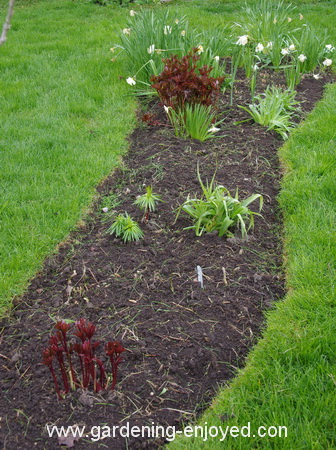 The road to somewhere is apparently paved with good intentions. This is one of my good intentions. Many of my gardens were sorely neglected last year when my shoulder surgery greatly curtailed my efforts. This is one of two mixed beds that hold my Asparagus and I have just spent several chilly hours cleaning it up and that aforementioned good intention is that I will weed it every week, when the weeds are small and easy to attack, so that it will always look like this. I’m working on the second bed as soon as sun warms us a bit more this afternoon. They have been filled with a long grass like growth that is coming from a small bulb and I think it is the Autumn Crocus that is spreading abundantly. I planted those crocus and I still like them but I don’t need several thousand of them hiding the asparagus and it would take a few years for each of them to reach blooming size. Out they go. Now several of
you will bring up the subject of mulch. I have a love / hate relationship with mulch. I have used several types over the years and find most of them leave large chips of wood behind as the smaller bits decompose. Mulch does decompose which contributes to the organic matter in the soil but to remain effective you need to take your truck to the garden centre and spend more money to top it up every year. I like spending the day in my garden and plan to move quickly through these beds on a regular basis knocking down the baby weeds. We’ll see what road my good intentions lead to. Amazingly I have found several large empty spaces in these beds, I guess I will have to find that Iris nursery web site!
The road to somewhere is apparently paved with good intentions. This is one of my good intentions. Many of my gardens were sorely neglected last year when my shoulder surgery greatly curtailed my efforts. This is one of two mixed beds that hold my Asparagus and I have just spent several chilly hours cleaning it up and that aforementioned good intention is that I will weed it every week, when the weeds are small and easy to attack, so that it will always look like this. I’m working on the second bed as soon as sun warms us a bit more this afternoon. They have been filled with a long grass like growth that is coming from a small bulb and I think it is the Autumn Crocus that is spreading abundantly. I planted those crocus and I still like them but I don’t need several thousand of them hiding the asparagus and it would take a few years for each of them to reach blooming size. Out they go. Now several of
you will bring up the subject of mulch. I have a love / hate relationship with mulch. I have used several types over the years and find most of them leave large chips of wood behind as the smaller bits decompose. Mulch does decompose which contributes to the organic matter in the soil but to remain effective you need to take your truck to the garden centre and spend more money to top it up every year. I like spending the day in my garden and plan to move quickly through these beds on a regular basis knocking down the baby weeds. We’ll see what road my good intentions lead to. Amazingly I have found several large empty spaces in these beds, I guess I will have to find that Iris nursery web site!To ask a question just “reply” to this ezine. Don’t forget to check the front page of the Website for frequent short ideas for current gardening activities. Norma Asks? I
took the picture of an with my phone. I have a question as I am planning to start my elephant ears tuber indoors. My question is - do I plant it as is or should I cut off the very extended bottom. Some of the tubers have pups beginning on the lower portion. |
| Back to Back Issues Page |
